Infiltration is usually a well-planned process but often terrorists continue repeating the very same routes on which their colleagues have been killed in droves. This is because of the compulsion they perceive of getting to the ‘reception area’ at the earliest. The reception area is a point to which a group of terrorists already inside the Valley move with basic logistics to receive and guide infiltrators to the nearby villages and subsequently to the safe houses in the urban areas. Routes which involve longer marches are generally avoided due to the feasibility of interception by surveillance of different kinds.
The LoC Fence – Concept and Execution
In 2003, under the stewardship of General NirmalVij, then Army Chief, the concept of counter infiltration finally changed with a landmark decision based on the experience of almost 15 years. For the first time a clear cut mission was given to commanders and troops in the Valley. ‘To reduce the strength of terrorists in the Valley and Jammu to sub 1000’; there could not have been a more specific mission. When such missions are given it is usually left to senior field commanders to evolve the concept of operations with resources being provided to match the concept as much as is feasible. General Vij in conjunction with his senior commanders conceptualized the LoC Fence as the ‘limit of infiltration’ demanding from field functionaries that it be continuous, overcoming terrain constraints. The LoC Fence did not become a Maginot Line as many claim but rather a system with the marrying of physical obstacles, electronic surveillance devices, weapons and human resources in varying ratios. Units and formations took ownership of their segments and focused counter infiltration efforts began in Jul 2004. The one item of equipment which acted as a force multiplier was the Hand Held Thermal Imager (HHTI) and its connected surveillance devices (LORROS), procured on fast track after Kargil 1999. Surveillance and Sub Surveillance Centers were set up integrating all inputs. Improvisation also became the norm with ‘Gaddi dogs’ (robust Gujjarowned dogs) became the eyes and ears on many posts. Units took the trouble of setting up training nodes for these dogs.
As the LoC Fence matured the quantum of successful operations increased exponentially. Some segments became virtually ‘no go’ areas for infiltration. Terrorists developed techniques to defeat the Fence but nothing really worked. The only lacuna was that the wire obstacle would get compressed by the huge volumes of soft snow in winter and the iron pickets would bend needing various high altitude segments to be reconstructed against time in Apr-May each year. This took away much time and energy from conventional preparedness.
The Effect of the LoC Fence
The combination of enhanced and focused counter infiltration employing the LoC Fence, much improved intelligence by all agencies, better coordination and sharing and finally far better dissemination, all helped in reducing infiltration. By 2007, more terrorists were being neutralized at the LoC and the hinterland by the SF than the number which could infiltrate. In 2008, a bold decision was taken to reinforce counter infiltration deployment by induction of troops from the Pir Panjal South to the Valley sector. The effect was enhanced control over infiltration with some very large contact battles in the Kupwarasector. This had a dampening effect on the situation in the hinterland which continued to improve. However, an indirect effect was the resort to street protests and small scale acts of terror in the hinterland.
The focused elimination of terrorist leaders from 2007 onwards further diluted terrorist capability. The progressive success of counter infiltration which reduced the numbers of terrorists from PoK reaching the urban and semi urban areas in the Valley had the following effect:-
- Large scale terrorist actions reduced drastically.
- Resort to gun snatching increased.
- IED incidents reduced and in fact almost completely vanished.
- New militancy characterized by presence of local Kashmiri youth progressively increased in South Kashmir with the hold of Pakistani terrorist leaders having reduced.
- Street protests on the slightest pretext found preference as a way of keeping alive the issue of Separatism.
- New methods of mass mobilization of street power to unnerve SF during encounters also found favour.
For the layman it is important to appreciate that at no point has infiltration ever reduced to zero. The Army always maintains that a zero figure is never possible to achieve. I can back that claim completely with my experience of handling counter infiltration at various levels from the lowest to the highest.
The surge in terrorist activity in recent weeks; is it due to enhanced infiltration? The Army would hotly contest that and rightly so because there have been a good number of successful operations in the vicinity of the LoCright through 2015-16. The indicators appear to show that infiltration is well under control. However, leakages do continue. North Kashmir where the presence and hold of foreign (Pakistani) terrorists is higher is relatively free of terror acts. Sopore, Bandipur, Pattan and Baramula are unusually quiet. There has been activity around Uri, Tangdhar and Lolab (all nearer the LoC) indicating successful and some unsuccessful counter infiltration operations. If terrorists have successfully reached their destinations there will be a spurt in violence just around early July when the tourists start returning home and the Sri Amarnath Yatra gathers more steam.
The Anantnag (South Kashmir) Situation
The events in Anantnag do not thus far seem related to any surge in infiltration. In yester years concentration of terrorists at Anantnag would also be from Jammu division infiltrating over the Pir Panjal. That may be possible even currently while the by-election is underway till 19 Jun. However, the strength in the Jammu division itself is extremely low and does not support that analogy.
The Army has to remain on alert at the LoC as there are areas which have not been exploited for some years. The routes over the Shamshabari in Uri sector, Naugam. Tangdhar, Pharkian and Zamindar Gali have been frequented far too often. Mostly the terrorists using these routes end up at the forest tracts – Rafiabad, Rajwar and Hafruda, which are under SF domination. Gurez and Gulmarg need some additional focus. Helicopter borne response teams are necessary for these areas along with UAV surveillance and observation.
Link with Situation in Pakistan
Infiltration efforts are also indirectly proportional to the internal situation in Pakistan. Now that the internal security environment is under better control and the closing months of General Raheel Sharif’s tenure are on a countdown, perhaps a surge is what the ISI could be planning for.
The LeT and JeM are rabid outfits and in their strategy major attrition of jihadis is acceptable as long as a few prominent leaders can be inducted along with some logistics, military wherewithal and lower end cadres. For an attempt by 100 terrorists they are willing to lose up to sixty percent if not more. That means the Army’s success in neutralizing terrorists on the Counter Infiltration grid may not necessarily mean reduced strength of terrorists in the hinterland especially if the Deep State in Pakistan decides that a surge is what it wishes. The only deduction from this; the counter infiltration machinery has to be fully geared up, reinforced if necessary with intelligence being generated and disseminated in near real time. None of that ‘put up on file’ business, which some warriors not used to the grid, may be wont to follow.
The lesson from this essay is that the focus of operations may be on New Militancy in South Kashmir and the mobs obstructing operations. That is all fine; operational and tactical. The real strategic level decision making is on bolstering the counter infiltration grid so that the progress of the last 13 years is not allowed to languish. The Army is up against a reinvigorated ISI which will look for innovative ways and areas to attempt to execute its aim of increasing the footprint of the sponsored terrorists in the Valley. There is no rest for the Army. Its 24x7 posture everywhere has to remain activated. That is most so on the LoC and the reception areas of North Kashmir. Rafiabad, Hafruda, Rajwar, Lolab and Tehgam, all household names in the lexicon of the Army in Kashmir’s vocabulary, which must remain dominated and free of terrorists. The flanks will also feel the pressure and the old traditional routes will need all the attention as focus shifts to those.
The Indian Army has to succeed; given its professionalism, it will succeed.
Concluded
Published Date: 16th June 2016, Image Source: http://www.rediff.com
(Disclaimer: The views and opinions expressed in this article are those of the author and do not necessarily reflect the official policy or position of the Vivekananda International Foundation)











Post new comment